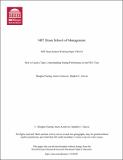How to Catch a Tiger: Understanding Putting Performance on the PGA Tour
Author(s)
Fearing, Douglas; Acimovic, Jason; Graves, Stephen C.
DownloadHow to Catch a Tiger 20100111 Final.pdf (1.086Mb)
Metadata
Show full item recordAbstract
Existing performance metrics utilized by the PGA TOUR have biases towards specific styles of play,
which make relative player comparisons challenging. Our goal is to evaluate golfers in a way that eliminates these
biases and to better understand how the best players maintain their advantage.
Through a working agreement with the PGA TOUR, we have obtained access to proprietary “ShotLink” data that
pinpoints the location of every shot taken on the PGA TOUR. Using these data, we develop distance-based models
for two components of putting performance: the probability of making the putt and the remaining distance to the pin
conditioned on missing. The first is modeled through a logistic regression, while the second is modeled through a
gamma regression. Both of these models fit the data well and provide interesting insights into the game.
Additionally, by describing the act of putting using a simple Markov chain, we are able to combines these two
models to characterize the putts-to-go for the field from any distance on the green for the PGA TOUR. The results
of this Markov model match both the empirical expectation and variance of putts-to-go.
We use our models to evaluate putting performance in terms of the strokes or putts gained per round relative to the
field. Using this metric, we can determine what portion of a player’s overall performance is due to advantage (or
loss) gained through putting, and conversely what portion of the player’s performance is derived off the green. We
demonstrate with examples how our metric eliminates significant biases that exist in the PGA TOUR’s Putting
Average statistic. Last, extending the concept of putts gained to evaluate player-specific performance, we show how
our models can be used to quickly
Date issued
2010-01Publisher
Cambridge, MA; Alfred P. Sloan School of Management, Massachusetts Institute of Technology
Series/Report no.
MIT Sloan School of Management Working Paper;4768-10
Keywords
Markov models, gamma regression, logistic regression, performance modeling, putting, golf